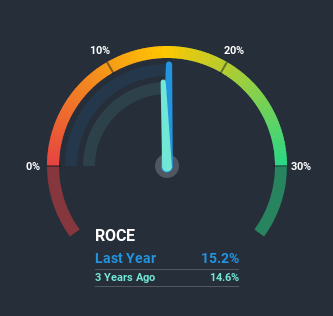Our Take On The Returns On Capital At Miller Industries (NYSE:MLR)

To find a multi-bagger stock, what are the underlying trends we should look for in a business? Amongst other things, we'll want to see two things; firstly, a growing return on capital employed (ROCE) and secondly, an expansion in the company's amount of capital employed. Basically this means that a company has profitable initiatives that it can continue to reinvest in, which is a trait of a compounding machine. So, when we ran our eye over Miller Industries' (NYSE:MLR) trend of ROCE, we liked what we saw.
What is Return On Capital Employed (ROCE)?
For those who don't know, ROCE is a measure of a company's yearly pre-tax profit (its return), relative to the capital employed in the business. Analysts use this formula to calculate it for Miller Industries:
Return on Capital Employed = Earnings Before Interest and Tax (EBIT) ÷ (Total Assets - Current Liabilities)
0.15 = US$42m ÷ (US$364m - US$90m) (Based on the trailing twelve months to June 2020).
Therefore, Miller Industries has an ROCE of 15%. On its own, that's a standard return, however it's much better than the 9.1% generated by the Machinery industry.
Check out our latest analysis for Miller Industries
Historical performance is a great place to start when researching a stock so above you can see the gauge for Miller Industries' ROCE against it's prior returns. If you want to delve into the historical earnings, revenue and cash flow of Miller Industries, check out these free graphs here.
How Are Returns Trending?
The trend of ROCE doesn't stand out much, but returns on a whole are decent. Over the past five years, ROCE has remained relatively flat at around 15% and the business has deployed 58% more capital into its operations. 15% is a pretty standard return, and it provides some comfort knowing that Miller Industries has consistently earned this amount. Over long periods of time, returns like these might not be too exciting, but with consistency they can pay off in terms of share price returns.
On a side note, Miller Industries has done well to reduce current liabilities to 25% of total assets over the last five years. Effectively suppliers now fund less of the business, which can lower some elements of risk.
Our Take On Miller Industries' ROCE
To sum it up, Miller Industries has simply been reinvesting capital steadily, at those decent rates of return. Therefore it's no surprise that shareholders have earned a respectable 68% return if they held over the last five years. So while investors seem to be recognizing these promising trends, we still believe the stock deserves further research.
While Miller Industries doesn't shine too bright in this respect, it's still worth seeing if the company is trading at attractive prices. You can find that out with our FREE intrinsic value estimation on our platform.
While Miller Industries may not currently earn the highest returns, we've compiled a list of companies that currently earn more than 25% return on equity. Check out this free list here.
This article by Simply Wall St is general in nature. It does not constitute a recommendation to buy or sell any stock, and does not take account of your objectives, or your financial situation. We aim to bring you long-term focused analysis driven by fundamental data. Note that our analysis may not factor in the latest price-sensitive company announcements or qualitative material. Simply Wall St has no position in any stocks mentioned.
Have feedback on this article? Concerned about the content? Get in touch with us directly. Alternatively, email editorial-team@simplywallst.com.

 Yahoo News
Yahoo News 

